Red Thorny Sea Star
Echinaster echinophorus
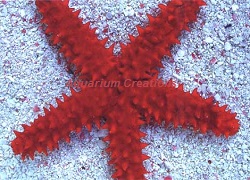
Description:
The Red Thorny Sea Star (Echinaster echinophorus) is sometimes called a Flame Red Thorny Starfish, a Red Thorn Back Starfish, or a Red Spiny Sea Star. It belongs to the family named Asteriidae. Typically reaching a max size of about 8.0 inches in length, the Red Thorny Sea Star is passive in nature and hardy in stamina. It's more active during the daytime and less at night, and will hang out across the entire tank. According to FishDB current data, captive breeding success is good and there are no external signs of sexual differences. Echinaster echinophorus in general should have standard (3 watts/gallon) light to thrive. Tank parameters should be maintained with ph level between 8.1 - 8.3, temperature between 77 - 79 degrees fahrenheit, and a salinity between 1.025 - 1.027.
Tank Recommendations:
They do best in tanks with live rock, and a sandy bottom, as this is their natural habitat.
Food and diet:
Should be actively fed a variety of fish foods into the sand. Otherwise, this voracious feeder will quickly clean your aquarium of detritus and left over food, and then starve, and eventually begin to decay.
Level of Care:
Moderate
Acclimaton Time:
1+ hours
Reef Compatibility
: Excellent
Approximate Purchase Size:
2" to 4"
|
|
Tile Sea Star, Orange/Red
Fromia monilis
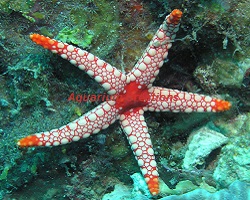
Description:
The Tile Sea Star is also called the Marble Sea Star, or Marble Starfish. Their patterns and colors make them one of the most striking. Coloration of the Tile Sea Star range from a deep red to orange, and both the central disc and the arms are mottled in a lighter coloration to cream, giving them the marbled look. Found over sandy substrates, on rocks, and sometimes climbing among corals and other invertebrates, they are constantly foraging for micro-organisms and detritus to eat, so the aquarium should have ample amounts of live rock. Tile Sea Stars generally lives alone, but if the aquarium is large enough to support more than one, it will tolerate others of its own species.
Tank Recommendations:
The Tile Sea Star should be kept with live rock, and a sandy bottom, as this is their natural habitat.
Food and diet:
Introduced to an established aquarium, very little needs to be done to supplement Fromia's. Occasional offerings of clam, mussel or scallop may be appreciated but rarely accepted. The bacterial film that comprises the mainstay of the Sea Stars diet usually appears in abundance in well established and seasoned aquariums. Supplemental feedings of meaty foods is usually not enough to sustain them.
Level of Care:
Moderate
Acclimaton Time:
1+ hours
Reef Compatibility
: Excellent
Approximate Purchase Size:
Small: 1" to 2", Medium: 2" to 3"
|
Small $29.99
Medium $34.99
|
Red Fromia Sea Star
Fromia milleporella
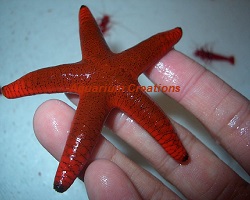
Description:
For those who pay sufficient attention to water quality and basic husbandry requirements, the Red Fromia Sea Star is a long-lived species that can add much to the beauty and ecology of the home aquarium. Though they only reach a size of about five or six inches, red fromia sea stars should be kept in systems of at least 30 gallons. As they can only survive in full-strength seawater, a specific gravity of at least 1.025 should be maintained. Found over sandy substrates, on rocks, and sometimes climbing among corals and other invertebrates, they are constantly foraging for micro-organisms and detritus to eat, so the aquarium should have ample amounts of live rock.
Tank Recommendations:
A well lit tank with live rock, and a sandy bottom, as this is their natural habitat.
Food and diet:
Introduced to a large well established aquarium, very little needs to be done to supplement Sea Stars. Occasional offerings of clam, mussel or scallop may be appreciated but rarely accepted. The bacterial film that comprises the mainstay of the Sea Stars diet usually appears in abundance in well established and seasoned aquariums. Supplemental feedings of meaty foods is usually not enough to sustain them.
Level of Care:
Moderate
Acclimaton Time:
1+ hours
Reef Compatibility
: Excellent
Approximate Purchase Size:
Small: 1" to 2", Medium: 2" to 3"
|
Small $29.99
Medium $34.99
|
|
|
Bahama Sea Star
Oreaster Reticulatis
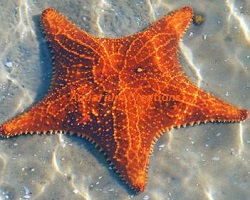
Description:
:The Bahama Sea Star also called the red cushion star is the largest sea star found within the caribbean seas, sometimes growing to as large as 20 inches in diameter. It usually has five thick, broad arms projecting from a broad cushioned disc but some specimens have four, six or seven. The upper surface is hard and is covered with blunt spines. The colour of adults is some shade of red, orange, yellow or brown. The juveniles are greenish-brown with mottled markings.
Tank Recommendations:
This starfish grows very large up to as much as 20 inces in diameter therefore it should be kept in very large aquariums. A tank with live rock, and a sandy bottom, as this is their natural habitat.
Food and diet:
Introduced to a large well established aquarium, very little needs to be done to supplement Sea Stars. Occasional offerings of clam, mussel or scallop may be appreciated but rarely accepted. The bacterial film that comprises the mainstay of the Sea Stars diet usually appears in abundance in well established and seasoned aquariums. Supplemental feedings of meaty foods is usually not enough to sustain them.
Level of Care:
Moderate
Acclimaton Time:
1+ hours
Reef Compatibility
: Excellent
Approximate Purchase Size:
3" to 5"
|
Chocolate Chip Sea Star
Protoreastor nodosus
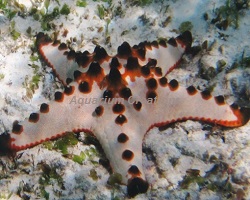
Description:
:A good choice for a peaceful community aquarium, but not good for a reef aquarium. The Chocolate Chip Starfish eats corals, clams, sponges, and some invertebrates. It is one of the easier starfish to keep and can do very well in established aquariums when provided with live rock and live sand to forage through. Also known as the Nodular Sea Star or the Horned Sea Star it is a species of sea star found in the warm, shallow waters of the Indo-Pacific region. Very popular for FOWLR (Fish Only With Live Rock) aquarium. They are brown, tan, orange, or black in color with black spots which resemble chocolate chips. Very hardy. Chocolate Chip Stars will spend the day cruising along rock and aquarium glass.
Tank Recommendations:
They are best kept in large aquariums because they grow to as much as 15 inches in diameter. A tank with live rock, and a sandy bottom, as this is their natural habitat.
Food and diet:
Introduced to a large well established aquarium, very little needs to be done to supplement Sea Stars. Occasional offerings of clam, mussel or scallop may be appreciated but rarely accepted. The bacterial film that comprises the mainstay of the Sea Stars diet usually appears in abundance in well established and seasoned aquariums. Supplemental feedings of meaty foods is usually not enough to sustain them.
Level of Care:
Moderate
Acclimaton Time:
1+ hours
Reef Compatibility
: Excellent
Approximate Purchase Size:
Small: 2" to 3"; Medium: 3" to 4"; Large: 4" to 6"
|
Small$10.99
Medium $11.99
Large $17.99
|
African Red Knob Sea Star
Protoreaster linckii
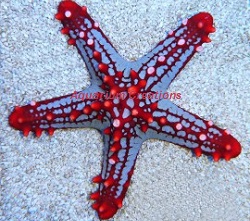
Description:
The African Red Knob Sea Star, is also known as the Red Spine Star, African Sea Star, and the Red-knobbed Starfish, has a thick silver-gray body with multiple bright red tubercles pointing upward along each of its arms. Found in the Indian Ocean. The African Red Knob Sea Star requires a large aquarium with ample supplies of live rock. A good choice for a peaceful community aquarium, but not good for a reef aquarium. The African Red Knobbed Sea Star eats corals, clams, sponges, and some invertebrates. It is one of the easier starfish to keep and can do very well in established aquariums when provided with live rock and live sand to forage through.
Tank Recommendations:
This starfish grow to between 10 and 12 inches in size and should be kept in large aquariums. A tank with live rock, and a sandy bottom, as this is their natural habitat.
Food and diet:
Introduced to a large well established aquarium, very little needs to be done to supplement Sea Stars. Occasional offerings of clam, mussel or scallop may be appreciated but rarely accepted. The bacterial film that comprises the mainstay of the Sea Stars diet usually appears in abundance in well established and seasoned aquariums. Supplemental feedings of meaty foods is usually not enough to sustain them.
Level of Care:
Moderate
Acclimaton Time:
1+ hours
Reef Compatibility
: Excellent
Approximate Purchase Size:
Small: 3" to 4" Medium: 4" to 5" Large: 5" to 6"
|
Small$44.99
Medium $49.99
Large $59.99
|
|
| |






